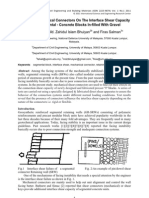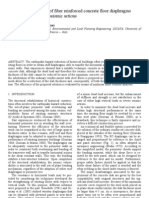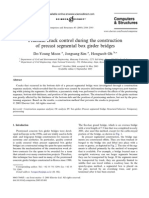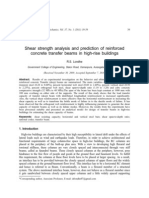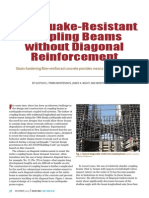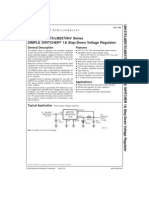Structure and Construction Examples of Tunnel Reinforcement Method Using Thin Steel Panels
Structure and Construction Examples of Tunnel Reinforcement Method Using Thin Steel Panels
Uploaded by
Mohamed H. JiffryCopyright:
Available Formats
Structure and Construction Examples of Tunnel Reinforcement Method Using Thin Steel Panels
Structure and Construction Examples of Tunnel Reinforcement Method Using Thin Steel Panels
Uploaded by
Mohamed H. JiffryOriginal Description:
Original Title
Copyright
Available Formats
Share this document
Did you find this document useful?
Is this content inappropriate?
Copyright:
Available Formats
Structure and Construction Examples of Tunnel Reinforcement Method Using Thin Steel Panels
Structure and Construction Examples of Tunnel Reinforcement Method Using Thin Steel Panels
Uploaded by
Mohamed H. JiffryCopyright:
Available Formats
NIPPON STEEL TECHNICAL REPORT No.
92 July 2005
UDC 624 . 191 . 8
Structure and Construction Examples of Tunnel Reinforcement Method Using Thin Steel Panels
Kazuaki KIRIYAMA*1 Minoru KAKIZAKI*1 Tsutomu TAKABAYASHI*1 Noriyuki HIROSAWA*2 Takashi TAKEUCHI*1 Hiroaki HAJOHTA*1 Yoshitaka YANO*1 Kenichiroh IMAFUKU*3
Abstract Recently, there have been many reports regarding tunnel structures where tunnel concrete lining has deformed (such as cracks, concrete flakes falling off and other types of deformation) due to external or internal factors such as aging, deformation of natural ground, and earthquakes. Therefore, going forward it will be increasingly important to provide proper repair and reinforcement to the tunnel lining, and consistently maintain and manage the tunnels. This paper introduces a method of reinforcing existing tunnel structure, called Tunnel Reinforcement Method using Thin Steel Panels, whereby steel panels are processed to a shape which is similar to the tunnel inner lining and installed within the tunnel as reinforcement. Each panel is bilaterally joined utilizing houndstooth- arrangement. This method has been developed by combining steel- board reinforcement work used for reinforcement of aqueduct tunnels and steel segment technology used for shield tunnels. We will introduce this method in this paper.
1. Introduction
In recent years, troubles with the concrete linings of tunnels, such as exfoliation, cracking and deformation due to aging, terrestrial transformation, earthquakes or other internal or external factors, have been reported from various parts of the country. Therefore, maintaining and managing tunnels on a continual basis while making the necessary repairs and reinforcement of their concrete linings have become important tasks both for the present and the future. In particular, the repair/reinforcement methods that are applied to railway and road tunnels must be such that the work can be carried out safely without interfering with traffic since railways and roads are the principal infrastructure for transportation. This paper will introduce a new tun*1 *2 Energy Facilities, Civil Engineering and Marine Construction Division Building Construction Division
nel reinforcement method that is applicable to both railway and road tunnels. This method permits speedily constructing a thin-walled reinforcement lining by applying pieces of steel plate (hereinafter referred to as panels) to the existing tunnel lining.
2. Characteristics of the New Tunnel Reinforcement Method
2.1 Characteristics and position of this method In this method, panels made of steel plate 8 to 20+ mm in thickness are applied to the inner surface of the tunnel to be reinforced. Their shapes are adjusted by utilizing a bar-like member (spacer) to secure an appropriate gap between the panel and the existing lin*3 Steel Research Laboratories
- 45 -
NIPPON STEEL TECHNICAL REPORT No. 92 July 2005
Fig. 1 Image of basic structure Fig. 2 Panel details and assembling method
ing. Then, the gap is filled with grout. Thus, this reinforcement method can be applied to prevent exfoliation of concrete lining, restrain ground disturbance, etc. (Fig. 1). The salient characteristics of this method are enumerated below. 1) Thin-walled structure: A reinforcement structure that is made up of panels can be worked into the desired shape according to the existing lining. Therefore, even where there is only a narrow space between the restriction boundary of a building and the existing lining, it is possible to construct a thin-walled reinforcement lining which does not cause the tunnel inner section to change significantly. 2) Prefab method: Since the panels are assembled by fitting together steel members prefabricated at the factory, the accuracy of fabrication of members is high and the field construction work can be carried out accurately. In addition, the panels are highly corrosion resistant. 3) High yield strength: Since the reinforcement lining is a freestanding arched structure constrained to the existing lining by grout filled in between the steel panel and the existing lining, it has high yield strength despite its limited thickness. 4) Permanent reinforcement measure: The freestanding structure mentioned above can be a permanent reinforcement measure when corrosion prevention appropriate to the tunnel environment is applied to it. 5) Speedy assembly work requiring no welding operation: Since the assembly of panels requires no welding operation, it can be done quickly even at midnight. Even during execution of the work, traffic through the tunnel is not impeded at all. 6) Smooth inner surface: The smooth inner surface of the reinforcement lining has aesthetic appeal and can easily be washed when stained. 2.2 Types and features of this method In accordance with the structure of the lining and the method of construction, this method is divided into the following three types: 1) Large panel type: A single steel plate is installed circumferentially by mechanical power. 2) Medium-sized panel type: Medium-sized pieces of steel plate are installed circumferentially by mechanical power. 3) Small panel type: Small pieces of steel plate are manually installed circumferentially (1) Characteristics of structure The large panel type can be applied to water conduits, etc., the existing lining of which is free of any installations. Here, we shall describe the medium-sized panel type and small panel type that are
applicable to many different tunnels. The salient characteristic of the panel structure is that panels provided with ring joints along the long sides and piece joints along the short sides are arranged in a staggered manner and the panel load is supported by the steel plate and joints (Fig. 2). Each type permits construction of a thin-walled reinforcement lining. Since the lining protrudes not more than about 50 mm toward the inner section, it can be installed even in locations subject to severe boundary restrictions from nearby buildings. Like shield segments, the joints play a role in load transmission by their splicing effect. The external force can be supported by two or more rings. (2) Characteristics of construction method As an example, the work execution procedure when mediumsized panels are applied to a railway tunnel is shown in Fig. 3. The
(1) Assembly of support leg and beam
(2) Installation of panels
(3) Grounting Fig. 3 Installation process by elector machine
- 46 -
NIPPON STEEL TECHNICAL REPORT No. 92 July 2005
panel size is 8 to 20+ mm thick, 1,000 mm wide and 2,000 to 3,000 mm long. A vehicle similar to the segment assembly vehicle employed in a shield tunnel is used to assemble the panels. It is equipped with a panel-holding mechanism (hereinafter referred to as the erector). The machine permits speedy assembly of the panels. When the small panel types are applied, they are assembled manually. Therefore, panels weighing less than 30 kg/piece are used. These panels are 8 mm thick, 400 mm wide and 1,000 mm long. This type can effectively be applied to tunnels which are too small to permit use of a construction vehicle. that the radial shear force is transmitted to the adjoining rings and the adjoining panels within the same ring. As a result, each pair of facing ribs can transmit the shear force regardless of whether it is positive or negative (Fig. 2). Water cut-off sponge applied to the four sides of each panel restrains the leakage of water from between the panels. 3.3 Joint strength test With the aim of determining the panel load-bearing characteristic and the joint strength characteristic, a loading experiment was conducted. The scene of the loading test is shown in Photo 1. The test pieces used were small panels (8 mm plate thickness 400 mm width 1,000 mm circumferential length; 4,200 mm R (steel plate outer surface)). From three rings of panels, a section (1,000 mm width, 2,000 mm circumferential length) was taken out and a variable concentrated load was applied to its center. The test results are shown in Fig. 5. In the figure, the calculated values and measured values obtained by using a beam-spring model with the fitting joints as shear springs (described later; see Fig. 6) are shown. In the analysis, the panel deflection () in the shear direction under load (P) was evaluated to set a shear spring constant (Kr = P/). By varying the joint spring constant until the calculated value agreed with the measured value, the shear spring constant could be determined.
3. Structural Characteristics and Design Method
3.1 Structural characteristics The panels form an arched structure. As already mentioned, it is a freestanding structure constrained by the existing lining and surrounding ground via the grout filled in between the panels and existing lining. Therefore, even though the arched structure has limited wall thickness, it is capable of resisting external force applied by exfoliation of the existing concrete lining, ground disturbance, etc. With the aim of roughly determining the reinforcement effect of steel plates applied to an existing lining, calculations were performed with a basic structure in which a single steel plate of uniform thickness was applied to a concrete lining. The calculation results are shown in Fig. 4. In anticipation of exfoliation of the lining concrete or loose soil pressure, six cases were analyzed in which the steel plate thickness (t) was varied between 8 mm, 16 mm and 24 mm and the tunnel diameter (D) was varied between 5 m and 10 m under a distributed load (W), as shown in the figure. In the analysis, it was assumed that each panel was a beam model and the ground spring was a nonlinear non-tension spring. As the compression-side spring constant (Kv), 50 MN/m3a value slightly on the small sidewas adopted for sandy soil. The steel plate used was SM 490, and the load under which it reached the permissible stress (a was assumed to be 185 N/mm2 in accordance with the Specifications of the Japan Road Association) was calculated. The calculation results show that, assuming the soils specific gravity to be 18 kN/m3, the structure can withstand loose soil pressure corresponding to loosening height 0.4 to 1.8 times the tunnel diameter (H = 4.81 to 8.81 m when D = 5 m; H = 3.95 to 8.17 m when D = 10 m). 3.2 Joint construction The joints are of a mechanically fitting construction (Fig. 2). During panel assembly, the panels are clamped together by bolts which are installed obliquely to prevent the panel joints from opening axially or circumferentially. Flat bars are provided as joint members between panels, and in expectation of the splicing effect produced by enabling the panels to mutually constrain their displacement in the shear direction, the joint structure has been so designed
Photo 1 Loading experiment
Fig. 4 Calculation model and result
Fig. 5 Comparison for experiment result and FEM analysis
- 47 -
NIPPON STEEL TECHNICAL REPORT No. 92 July 2005
which the panel can be fitted in the axial direction of the tunnel is installed as a panel-supporting member. When panels are to be installed only in the upper part of the tunnel section, support legs up to the bottom end of the panel installation are erected on the ground and a panel-supporting beam is installed on those support legs. When support legs are erected, empty grout bags are previously placed behind them. After the panels are installed, grout is put into those bags to fill the gap between the existing and new linings. 4.4 Panel installation When small panels are employed, the panels are manually brought to the installation location and assembled on a simple scaffold. The panels are continuously assembled in the circumferential direction of the tunnel using standard tools (e.g., wrenches). No special equipment is required for panel assembly. During panel assembly, the panels are temporarily fixed to the existing lining with furnished anchors in order to control the gap between the existing lining and the panel used for panel positioning and shape adjustment, and to prevent deformation of the panels during grouting. When medium-sized panels are employed, the panels are positioned by a construction vehicle equipped with an erector (because they are heavier) and installed in the same way as mentioned above. 4.5 Grouting The gap between the panels and the existing lining is filled with grout either directly or by means of bags. In the latter case, a bag is attached to the back of each panel before assembly and after all the panels are installed, grout is injected into the bags from the inside of the panels through the grouting holes. An ordinary cement-based grouting material whose spring stiffness is equal to or greater than that of the surrounding ground is used. Although direct grouting is the norm, grouting by means of bags may be selected depending on conditions at the construction site. The advantages of using bags for grouting are as follows. 1) Water which leaks from the lining can be drained through the gaps between bags. 2) An end plate to stop the flow of grout can be omitted. 3) Grout does not flow out through cracks, etc. in the lining. 4) Since leaking water does not mix with the grout, the grout quality is maintained for a prolonged period. 4.6 Restoration of wiring, etc. After the work is completed, the metallic supports are refitted to the panels and the wiring, lighting equipment, etc. that have been relocated temporarily are reinstalled in their original positions.
Fig. 6 Frame-spring analysis model
3.4 Design method 3.4.1 Structural models (1) Structural models In this design, based on the results of the above experiment, an analysis is made by using a beam-spring model, with the panel modeled as the circumferential beam model and the joints modeled as described below (Fig. 6). (i) Ring joint The ring joint is modeled as a radial shear spring. As the spring constant of the shear spring, the spring constant that was obtained in the above experiment is set. (ii) Piece joint The piece joint is modeled as a pin joint which transmits the axial force between circumferential panels (piece joint) but which does not transmit the bending moment between them. (2) Ground spring In the study made during the work, as the point-supported ground spring via the portion from the ground to the spacer in the radial direction, only a nonlinear, non-tension spring is considered. In the study after completion of the reinforcement lining as a permanent structure, the reaction from the portion from the grout to the ground is considered. As the ground spring, a nonlinear, nontension spring which is assumed as a distribution spring via the portion from the ground to the grout in the radial direction is considered. 3.4.2 Design load After completion of the reinforcement lining, the panel weight, air pressure during the passing of a train (or motor vehicle), grout weight, exfoliation load and soil load are considered as the design load. During the work, consideration is given to the load that increases as the grouting process progresses.
5. Examples of Works Executed 4. Types and Methods of the Work
4.1 Survey and design The cross-section shape of an existing tunnel is surveyed in detail by using an optical range finder or some other suitable instrument. This is to determine the relative positions of the existing lining and restriction boundary lines of adjacent buildings and to design a cross section of the panel installation that minimizes the decrease in tunnel cross section due to the reinforcement. 4.2 Relocation of wiring, etc. As far as possible, the electrical wiring, communication/signal lines, lighting equipment, metallic supports, etc. that are installed in the tunnel lining need to be removed or relocated temporarily before commencement of the reinforcement work from the standpoint of securing the safety of wiring and facilitating the work. 4.3 Installation of panel support legs and beams At the bottom end of the panel installation, a grooved beam into 5.1 Work on subway tunnel Use: Single-track subway tunnel (constructed in 1963) Tunnel inner section: Height H = 5.4 m, breadth B = 6.8 m Length reinforced: 4 m (straight section) Panel construction: Small panel (16 pieces/ring 10 rings), t = 8 mm Construction time: About 3 hours/day (from cessation of power after the last train until restarting prior to the first train) The subway tunnel had a primary lining of concrete segments and a secondary lining of concrete applied to the primary lining. In this work, which was carried out as a measure to prevent the exfoliation of concrete of the secondary lining, panels were applied to the entire inner surface of the existing tunnel lining for a length of 4 m. The method used was the small panel type and the panels were assembled and applied manually. Since the wiring inside the tunnel
- 48 -
NIPPON STEEL TECHNICAL REPORT No. 92 July 2005
tory tests that the sponge prevents grout leakage even up to pressures of 0.2 MPa. The panels could be installed with a high degree of precision, with the cross-section shape after the work showing only about a 5 mm margin of error from the design dimensions (Photo 2). 5.2 Work at road tunnel1) Use: Road tunnel with 2 lanes in each direction (constructed in 1973) Inner section: Height H = 6.4 m, breadth B = 9.9 m Length reinforced: 40 m Panel construction: Medium-sized panels (9 pieces/ring), t = 24 mm Construction time: About 8 hours/day (two lanes blocked alternately) This work was carried out as a measure to reinforce the tunnel lining so as to prevent deformation under the ground load and other loads applied to it from above. The tunnel was a structure bearing the vertical load of a 9 m-thick overburden. The construction method used was the medium-sized panel type and the panels were applied by mechanical power. The cross sections of the tunnel and reinforcement lining and the work execution procedure are shown in Fig. 8. The panels are made from SM 490, each measuring 1 m 2 m and weighing 400 to 500 kg. An erector machine equipped at the front end with a hydraulic adjustment jig for fine adjustment of panel positions (Photo 3) was used to facilitate panel handling and speed up panel assembly. As a result, the work progressed at a pace of about 1 ring per day despite the fact that the two lanes were blocked alternately to avoid a complete shutdown of traffic. In addition, at the construction site, efforts were made to reduce temporary installations and workspace in order to minimize the impact on the environment (Photo 4). 5.3 Other examples of work executed (1) Road tunnel (Photo 5) Use: Road tunnel with one lane in each direction (constructed in 1930)
Fig. 7 Panel arrangement for tunnel section
Photo 2 Example of construction for subway tunnel
could not be relocated to the ground, the metal fittings for the wiring were replaced with smaller ones to secure adequate clearance from the existing lining for insertion of the panels. The inner section of the tunnel and the cross section and the reinforcement lining are shown in Fig. 7. By using a construction vehicle equipped with a scaffold capable of being moved up and down, the work progressed at a pace of 2 to 3 rings per day. Grout was directly injected into the open space behind the panels without using bags. A 5 mm-thick sponge pad was sandwiched between panels to stop water leaks. It has been confirmed in labora-
Photo 3 Installation of panel by elector machine
Fig. 8
Section design and installation of panel
- 49 -
NIPPON STEEL TECHNICAL REPORT No. 92 July 2005
Photo 4 Completion Photo 6 Example of railway tunnel
Inner section: Height H = 5.2 m, breadth B = 4.6 m Length reinforced: 31 m Panel construction: Small panel (support legs + 8 panels/ring), t = 8 mm
6. Conclusion
It has been demonstrated that the method described above permits the speedy and safe construction of a reinforcement structure even in locations where the restrictions from buildings are severe. Thus, it is possible to establish a new, permanent measure to rehabilitate tunnel structures. We hope that our method will be applied to many different tunnel structures in the future.
Photo 5 Example of road tunnel
Inner section: Height H = 6.5 m, breadth B = 9.0 m Length reinforced: 75 m Panel construction: Small panel (16 pieces/ring), t = 8 mm (2) Railway tunnel (Photo 6) Use: Conventional, non-electrified, single-track railway tunnel (constructed in 1933)
Acknowledgments We wish to express our heartfelt gratitude to Mr. Yoshiji Matsumoto, professor emeritus at the University of Tokyo, for his generous cooperation in establishing this new structure and construction method. References
1) Kiga, K.: Nikkei Construction (2004.10.8), 32(2004)
- 50 -
You might also like
- ToS Case StudiesDocument44 pagesToS Case Studieskshipra gandhi100% (1)
- 6-Impact of Adhesive Thickness On The Capacity of The Surface Mounting Steel Plates Strengthening TechniqueDocument9 pages6-Impact of Adhesive Thickness On The Capacity of The Surface Mounting Steel Plates Strengthening TechniqueMr A. M. OlajumokeNo ratings yet
- Reinforced Concrete Buildings: Behavior and DesignFrom EverandReinforced Concrete Buildings: Behavior and DesignRating: 5 out of 5 stars5/5 (1)
- Network Diagram and Critical PathDocument28 pagesNetwork Diagram and Critical PathMohamed H. JiffryNo ratings yet
- Fiber Optics Problems and SolutionsDocument57 pagesFiber Optics Problems and SolutionsIoana Harabagiu100% (8)
- Bridges Spanish HSRLDocument13 pagesBridges Spanish HSRLVelugoti VijayachandNo ratings yet
- Introduction of Transition Zone Design For Bridge Deck Link Slabs Using Ductile ConcreteDocument10 pagesIntroduction of Transition Zone Design For Bridge Deck Link Slabs Using Ductile Concreteicv.xaviNo ratings yet
- International Practices For Connecting One Pass Precast Segmental Tunnel LiningsDocument7 pagesInternational Practices For Connecting One Pass Precast Segmental Tunnel LiningsMehdi BakhshiNo ratings yet
- Dynamic Testing of Multi-Storey Post-Tensioned Glulam Building: Planning, Design and Numerical AnalysisDocument10 pagesDynamic Testing of Multi-Storey Post-Tensioned Glulam Building: Planning, Design and Numerical AnalysisGayanNo ratings yet
- Segmental Post-Tensioned Concrete BridgesDocument12 pagesSegmental Post-Tensioned Concrete BridgesDimitri Mn100% (2)
- Thin Post-Tensioned Concrete Shell StructuresDocument4 pagesThin Post-Tensioned Concrete Shell StructuresicivalmyNo ratings yet
- Applied Sciences: Fatigue Assessment of Prestressed Concrete Slab-Between-Girder BridgesDocument19 pagesApplied Sciences: Fatigue Assessment of Prestressed Concrete Slab-Between-Girder BridgesefvjNo ratings yet
- An Experimental Investigation of The Stress-Strain Distribution in High Strength Concrete Deep BeamsDocument10 pagesAn Experimental Investigation of The Stress-Strain Distribution in High Strength Concrete Deep BeamsBurhan ManzoorNo ratings yet
- Code Tiltup PrecastDocument47 pagesCode Tiltup Precastkorosh75No ratings yet
- Copy ManuscriptDocument20 pagesCopy ManuscriptSREEKUMARA GANAPATHY V S stellamaryscoe.edu.inNo ratings yet
- The Lully Viaduct, A Composite Bridge With Steel Tube TrussDocument11 pagesThe Lully Viaduct, A Composite Bridge With Steel Tube Trusssofronije2005No ratings yet
- Tunnels in Weak RockDocument15 pagesTunnels in Weak RockSandeep AggarwalNo ratings yet
- Kurz 2012 Paper EnglishDocument14 pagesKurz 2012 Paper EnglishPrayush RajbhandariNo ratings yet
- Influence of Selected Parameters On Design Optimisation of Anchor JointDocument10 pagesInfluence of Selected Parameters On Design Optimisation of Anchor JointMiguel Rivera100% (1)
- Faisal HJ Ali, Md. Zahidul Islam Bhuiyan and Firas SalmanDocument8 pagesFaisal HJ Ali, Md. Zahidul Islam Bhuiyan and Firas SalmanZahid BhuiyanNo ratings yet
- Rohit. S. DasariDocument9 pagesRohit. S. DasarirohitNo ratings yet
- Jacketing of Column 122Document6 pagesJacketing of Column 122solomonceNo ratings yet
- 2010 Nonlinear FE Analysis of FRC Floor Diaphragms Undergoing Horizontal Seismic ActionsDocument6 pages2010 Nonlinear FE Analysis of FRC Floor Diaphragms Undergoing Horizontal Seismic ActionsPratikNo ratings yet
- Concrete Filled Steel TubesDocument24 pagesConcrete Filled Steel TubesSIJAN SHRESTHA100% (1)
- Link Slab Deck JointsDocument20 pagesLink Slab Deck JointsAnton Husen PurboyoNo ratings yet
- Materials and Jacketing TechniqueDocument5 pagesMaterials and Jacketing TechniqueHoussam Al MoussawiNo ratings yet
- The Design of Langqi Min River Bridge, Fuzhou, China: Min Zhang Tianbo Wan Yingliang WangDocument6 pagesThe Design of Langqi Min River Bridge, Fuzhou, China: Min Zhang Tianbo Wan Yingliang WangmasteriragaNo ratings yet
- Camasuire Stalp Cu FerocimentDocument8 pagesCamasuire Stalp Cu FerocimentChelemen MaryaNo ratings yet
- Bridge Journal DDocument10 pagesBridge Journal DJalu NarayanaNo ratings yet
- Analysis and Design of Ferrocement Panels An Experimental StudyDocument8 pagesAnalysis and Design of Ferrocement Panels An Experimental StudyNick CordetaNo ratings yet
- CE 416 Prestressed Concrete Sessional (Lab Manual)Document64 pagesCE 416 Prestressed Concrete Sessional (Lab Manual)RahulKikaniNo ratings yet
- CE 416 Prestressed Concrete Sessional (Lab Manual)Document64 pagesCE 416 Prestressed Concrete Sessional (Lab Manual)julesNo ratings yet
- Shear Strength Analysis and Prediction of Reinforced Concrete Transfer Beams in High-Rise BuildingsDocument21 pagesShear Strength Analysis and Prediction of Reinforced Concrete Transfer Beams in High-Rise Buildingsmohammed_fathelbabNo ratings yet
- ADAPT Slab Column ConnectionDocument8 pagesADAPT Slab Column Connectionhakim2020No ratings yet
- Suspension Bridge Construction Over Irtysh River, KazakhstanDocument10 pagesSuspension Bridge Construction Over Irtysh River, KazakhstanHye Yeon KimNo ratings yet
- Matecconf gcmm2017 03024 PDFDocument7 pagesMatecconf gcmm2017 03024 PDFreza39No ratings yet
- Behaviour of A Steel Bridge Equipped With Seismic Isolation DevicesDocument10 pagesBehaviour of A Steel Bridge Equipped With Seismic Isolation DevicesbulbucataNo ratings yet
- Study On FlexuralDocument8 pagesStudy On FlexuralRafael CuaNo ratings yet
- Prestressed Concrete Structures - AssignmentDocument11 pagesPrestressed Concrete Structures - AssignmentAlbinPSunnyNo ratings yet
- The Rehabilitation of The Oldest Transit Tunnel in The United StatesDocument8 pagesThe Rehabilitation of The Oldest Transit Tunnel in The United StatesHarold TaylorNo ratings yet
- Composite Slabs DLam 1Document11 pagesComposite Slabs DLam 1Massimo LatourNo ratings yet
- Matecconf Matbud2018 02003Document8 pagesMatecconf Matbud2018 02003mcivil 9No ratings yet
- EW Resistant Coupling BeamsDocument5 pagesEW Resistant Coupling Beamscadel100% (1)
- Analytical Performance of CFST Columns Under Axial CompressionDocument10 pagesAnalytical Performance of CFST Columns Under Axial CompressionIJRASETPublicationsNo ratings yet
- Torsion of High-Strength Reinforced Concrete Beams and Minimum Reinforcement RequirementDocument8 pagesTorsion of High-Strength Reinforced Concrete Beams and Minimum Reinforcement RequirementSuhas Natu100% (1)
- Applications of Sustainable Post-Tensioned Concrete SlabsDocument12 pagesApplications of Sustainable Post-Tensioned Concrete Slabsmohamed.s.elsayedNo ratings yet
- Composite Cold-Formed Steel-Concrete Structural System Composite Cold-Formed Steel-Concrete Structural SystemDocument27 pagesComposite Cold-Formed Steel-Concrete Structural System Composite Cold-Formed Steel-Concrete Structural SystemVladimirNo ratings yet
- 2022Document3 pages2022Ashish KumarNo ratings yet
- Study On The Design of Chirajara BridgeDocument8 pagesStudy On The Design of Chirajara Bridgepaul ostepNo ratings yet
- Study of Effects and Behavior of Cold Joints in Concrete: Kshitiz Lamichhane Tek Raj Gyawali, Buddhi Raj JoshiDocument10 pagesStudy of Effects and Behavior of Cold Joints in Concrete: Kshitiz Lamichhane Tek Raj Gyawali, Buddhi Raj JoshiKshitiz LamichhaneNo ratings yet
- Ugur ErsoyDocument16 pagesUgur ErsoyTeknomdepo TeknomdepoNo ratings yet
- Technical Paper - The Lateral Capacity of Insulated Sandwich Panel Under Static Lateral LoadingDocument9 pagesTechnical Paper - The Lateral Capacity of Insulated Sandwich Panel Under Static Lateral LoadingNurul Ain Jamari100% (1)
- Design Notes For ALL Memebres - Sefi ForumDocument17 pagesDesign Notes For ALL Memebres - Sefi ForumcoolkaisyNo ratings yet
- M 5 StajDocument10 pagesM 5 Stajafzal taiNo ratings yet
- Feasibility of Using Self-Compacting Concrete in C PDFDocument14 pagesFeasibility of Using Self-Compacting Concrete in C PDFAbdelrhman NagyNo ratings yet
- Effect of Steel Pins On Interface Shear Behavior of Segmental Concrete UnitsDocument7 pagesEffect of Steel Pins On Interface Shear Behavior of Segmental Concrete UnitsZahid BhuiyanNo ratings yet
- Elplanation of Excessive Long Time Deflections of Collapsed Record Span Box Girder BridgesDocument32 pagesElplanation of Excessive Long Time Deflections of Collapsed Record Span Box Girder BridgesEr.Praveen RajNo ratings yet
- Al-Khafaji - Structural Behavior of Normal and High Strength Concrete WallPanels Subjected To Axial Eccentric Uniformly DistributedDocument20 pagesAl-Khafaji - Structural Behavior of Normal and High Strength Concrete WallPanels Subjected To Axial Eccentric Uniformly DistributedKamirã Barbosa RibeiroNo ratings yet
- Seismic Design of Buried Structures As 5100Document6 pagesSeismic Design of Buried Structures As 5100Chen Wai PengNo ratings yet
- A Short Guide to the Types and Details of Constructing a Suspension Bridge - Including Various Arrangements of Suspension Spans, Methods of Vertical Stiffening and Wire Cables Versus Eyebar ChainsFrom EverandA Short Guide to the Types and Details of Constructing a Suspension Bridge - Including Various Arrangements of Suspension Spans, Methods of Vertical Stiffening and Wire Cables Versus Eyebar ChainsNo ratings yet
- Neural Networks 2Document38 pagesNeural Networks 2Mohamed H. JiffryNo ratings yet
- J-Control Elements: BackgroundDocument9 pagesJ-Control Elements: BackgroundMohamed H. JiffryNo ratings yet
- Details HVACDocument6 pagesDetails HVACklaydenNo ratings yet
- Use of Neural Network Ensembles For Portfolio Selection and Risk ManagementDocument22 pagesUse of Neural Network Ensembles For Portfolio Selection and Risk ManagementMohamed H. JiffryNo ratings yet
- 978-1-58503-738-4 - Autodesk Revit 2013 BIM Management Template and Family Creation - 978-1-58503-738-4-1Document78 pages978-1-58503-738-4 - Autodesk Revit 2013 BIM Management Template and Family Creation - 978-1-58503-738-4-1Mohamed H. JiffryNo ratings yet
- SIKA Shotcrete HandbookDocument38 pagesSIKA Shotcrete Handbooktantenghui100% (1)
- Tunnel Construction MethodDocument36 pagesTunnel Construction MethodMohamed H. Jiffry83% (6)
- Tunnel and Shaft SolutionsDocument48 pagesTunnel and Shaft SolutionsMohamed H. Jiffry100% (4)
- Underground Construction: Consumer Business ServicesDocument16 pagesUnderground Construction: Consumer Business ServicesMohamed H. JiffryNo ratings yet
- Tunnelling MethodsDocument15 pagesTunnelling Methodsrohit_iitd080% (1)
- Files-2 - Handouts Lecture-24 To 26Document28 pagesFiles-2 - Handouts Lecture-24 To 26บดินทร์แพรวพราวNo ratings yet
- LM1575/LM2575/LM2575HV Series SIMPLE SWITCHER® 1A Step-Down Voltage RegulatorDocument25 pagesLM1575/LM2575/LM2575HV Series SIMPLE SWITCHER® 1A Step-Down Voltage RegulatorSherif EltoukhiNo ratings yet
- Andarani2013 Indonesia Ewaste Potential PDFDocument15 pagesAndarani2013 Indonesia Ewaste Potential PDFcipta panghegarNo ratings yet
- Parts 3121128 04-15-08 ANSI EnglishDocument230 pagesParts 3121128 04-15-08 ANSI Englishroque cardosoNo ratings yet
- Rationalism Romanticism Transcendentalism 2012Document21 pagesRationalism Romanticism Transcendentalism 2012Ms. Katie PetersonNo ratings yet
- Customized Meal Plan For Rapid Weight LossDocument3 pagesCustomized Meal Plan For Rapid Weight LossPramesh MallaNo ratings yet
- (PDF) earthAndLifeScience Week05Document39 pages(PDF) earthAndLifeScience Week05John Lester M. Dela CruzNo ratings yet
- Sample LEED PlanDocument36 pagesSample LEED Planskip_16157No ratings yet
- JN1404 - Lap Joint Flange & Stub End - RaDocument1 pageJN1404 - Lap Joint Flange & Stub End - RaRiyan EsapermanaNo ratings yet
- NDT Testing University of MauritiusDocument12 pagesNDT Testing University of MauritiusAadil Bo SpitzmausNo ratings yet
- Sexually Transmitted Infections Basics in DiagnosisDocument95 pagesSexually Transmitted Infections Basics in Diagnosistummalapalli venkateswara raoNo ratings yet
- Understanding Culture, Society and Politics: Quarter 1 Lesson 1: AnthropologyDocument13 pagesUnderstanding Culture, Society and Politics: Quarter 1 Lesson 1: AnthropologyMariel SantosNo ratings yet
- Ekspedisi Ke Gunung Tahan, PahangDocument7 pagesEkspedisi Ke Gunung Tahan, PahangwynaNo ratings yet
- Gateway Technology: M.Phil. Biotechnology CBM, University of SwatDocument9 pagesGateway Technology: M.Phil. Biotechnology CBM, University of SwatGul AfshaNo ratings yet
- Security Awareness HandoutDocument21 pagesSecurity Awareness HandoutDEVENDRA KISHORENo ratings yet
- December 363926Document60 pagesDecember 363926rail32100% (1)
- I. Non-Core Vocabulary and Slang: The Paper Menagerie WorksheetDocument4 pagesI. Non-Core Vocabulary and Slang: The Paper Menagerie WorksheetmclaramcNo ratings yet
- Example of Explanation TextDocument1 pageExample of Explanation TextEko Pamungkas50% (2)
- Elk-4 800 1HZC208015 201610 PDFDocument16 pagesElk-4 800 1HZC208015 201610 PDFDave ChaudhuryNo ratings yet
- Dost Steel Container PDFDocument2 pagesDost Steel Container PDFSyambabuNo ratings yet
- Detailed Lesson Plan in English IiDocument8 pagesDetailed Lesson Plan in English Iimanilyn100% (1)
- Tell Me About YourselfDocument3 pagesTell Me About YourselfMiranda EvelynNo ratings yet
- Easy Masoor Dal - Make It Dairy FreeDocument2 pagesEasy Masoor Dal - Make It Dairy Free4569854tjzNo ratings yet
- RMC Plant Calibration 1 (12.05.2016)Document7 pagesRMC Plant Calibration 1 (12.05.2016)jitendraNo ratings yet
- SemicondDocument334 pagesSemicondBharathNo ratings yet
- Parcial III-mecánica de Fluidos-201630Document1 pageParcial III-mecánica de Fluidos-201630CristianSuarezNo ratings yet
- GK BookDocument115 pagesGK BookPriyanka Jain0% (1)
- Siwes Report by ZainabDocument26 pagesSiwes Report by ZainabHardex Star kidNo ratings yet
- Firefighter 12 Week Fitness ProgrammeDocument13 pagesFirefighter 12 Week Fitness ProgrammecampschettyNo ratings yet
- Analyzing The Influence of Body Composition On Sports Performance in Nigerian Football Players.Document76 pagesAnalyzing The Influence of Body Composition On Sports Performance in Nigerian Football Players.jamessabraham2No ratings yet



















